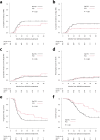Prophylactic cranial irradiation for limited-stage small-cell lung cancer in the modern magnetic resonance imaging era may be omitted: a propensity score-matched analysis
- PMID: 39478663
- PMCID: PMC11630028
- DOI: 10.1093/jrr/rrae087
Prophylactic cranial irradiation for limited-stage small-cell lung cancer in the modern magnetic resonance imaging era may be omitted: a propensity score-matched analysis
Abstract
We aimed to clarify whether prophylactic cranial irradiation (PCI) is associated with improved outcomes in limited-stage small-cell lung cancer (LS-SCLC) in the current era of magnetic resonance imaging (MRI). Data from patients with LS-SCLC who achieved a complete response to definitive chemoradiotherapy (CRT) at two medical centers were retrospectively reviewed. Propensity score-matching was performed in a 2:1 ratio to balance the baseline characteristics of the no-PCI and PCI groups. The endpoints were the incidence of brain metastasis (BM), neurological causes of death and overall survival (OS). Overall, 80% patients underwent head MRI during the initial staging and 75 patients (no-PCI, n = 50; PCI, n = 25) were matched. Their baseline characteristics were generally well-balanced except for age; patients in the no-PCI group tended to be older. The median follow-up period was 29 months. Although the incidence of BMs tended to be higher in the no-PCI group (1-year BM occurrence: 26% vs 17%, P = 0.22), the incidence of multiple BMs (defined as >4 metastases) was similar between groups (1-year multiple BMs occurrence: 8% vs 9%, P = 0.65). The 2-year neurological causes of death and OS rate did not significantly differ between the groups (6% and 9%; P = 0.85; and 70% and 79%; P = 0.36, respectively). The 1-year occurrence of multiple BMs did not increase, even without PCI, when modern imaging modalities were integrated into the initial diagnosis, suggesting that PCI could be omitted after CRT, if MRI was incorporated into the initial diagnosis and follow-up.
Keywords: limited-stage small-cell lung cancer; magnetic resonance imaging; propensity score-matched analysis; prophylactic cranial irradiation.
© The Author(s) 2024. Published by Oxford University Press on behalf of The Japanese Radiation Research Society and Japanese Society for Radiation Oncology.
Conflict of interest statement
Kei Ito has received payment or honoraria for lectures, presentations or educational events from Varian Medical Systems K. K. Yukio Hosomi serves on the speaker’s bureau for AstraZeneca, Taiho Pharmaceutical, Eli Lilly Japan, Chugai Pharma, Ono Pharmaceutical, Bristol-Myers Squibb Japan, Merck Sharp & Dohme K.K., and Kyowa Kirin International. Other than these, there are no conflicts of interest to report.
Figures


References
-
- Glantz MJ, Choy H, Yee L. Prophylactic cranial irradiation in small cell lung cancer: rationale, results and recommendations. Semin Oncol 1997;24:477–83. - PubMed
-
- National Comprehensive Cancer Network . National Comprehensive Cancer Network (NCCN) Guidelines. Small Cell Lung Cancer; Version: 2, 2024, https://www.nccn.org/professionals/physician_gls/pdf/sclc.pdf (10 March, 2024, date last accessed).
MeSH terms
LinkOut - more resources
Full Text Sources
Medical
Research Materials
Miscellaneous

